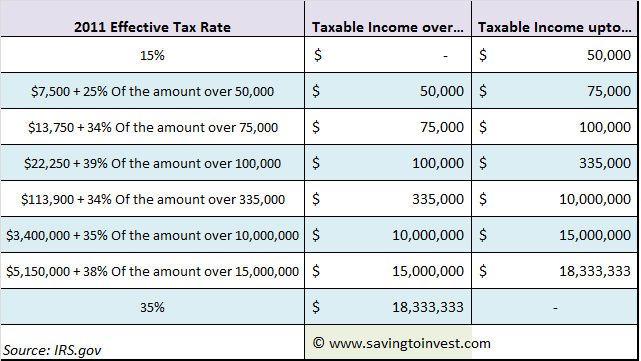2011 Tax Rates
The 2011 corporate tax rates are the same as the last few years as shown in the table below. While the tax rate structure may not look uniform, it does produce an effective flat tax rate of 34% for incomes from $335,000 to $10,000,000, gradually increasing to a rate of 35% on higher taxable incomes. Different corporations and business’ are subject to special tax provisions for which the IRS website should be consulted. Further, corporations are subject to state and local taxes based on the area in which they are incorporated and/or operate.

Temporary exclusion of 100% of gain on certain small business stock
Business’ now have an additional incentive for investment in qualified small businesses, whereby investors in qualified small business stock can exclude 100% of the capital gain upon sale of the stock. The exclusion under this provision is not an item of tax preference for purposes of the alternative minimum tax. In order to claim the capital gain exclusion, the qualified small business stock must be:
1. Acquired after September 27, 2010, and before Jan. 1, 2011, and
2. Held for at least five years before the stock is sold.
Under current law, the earliest tax year for which this 100% capital gain exclusion can be claimed is 2015. Additional limitations, qualifications and requirements may apply.
General business credits of eligible small businesses for 2010 carried back 5 years
New provisions now allow an eligible small business to carry back general business credits five years. Previously, the credits could only be carried back one year. The carry back is for credits determined in the first taxable year beginning after December 31, 2009. An “eligible small business” in general is defined as follows:
1. A corporation whose stock is not publicly traded, a partnership, or a sole proprietorship, and
2. The taxpayer must have $50,000,000 or less in average annual gross receipts over the three preceding tax years.
General business credits of eligible small businesses in 2010 not subject to alternative minimum tax
The new laws allow general business credits to offset both regular income tax and alternative minimum tax of eligible small businesses (defined above). The provision is effective for any general business credits determined in the first taxable year beginning after December 31, 2009, and to any carry back of such credits.
Temporary reduction in S-Corporation built-in gain recognition period
Under the Small Business Jobs Act, if the fifth year of an S Corporation’s recognition period ends before their 2011 taxable year begins, then no tax is imposed on the net recognized built-in gain for the 2011 tax year. Built-in Gains are recognized on Form 1120S Schedule D, Capital Gains and Losses and Built-in Gains. The 2011 Instructions for Schedule D, Form 1120S, will be revised and made available shortly.
Increased expensing limitations for 2010 and 2011; certain real property treated as Code section 179 property.
An expense deduction is allowed for businesses which choose to treat the cost of certain qualified property, called section 179 property, as an expense rather than a capital expenditure. For qualifying property placed in service during the taxable years 2010 and 2011, the new law increases both the maximum amount of the deductible expense, as well as the statutory phase-out amount. The provision also allows an election by a taxpayer to exclude qualified real property from the definition of IRC Section 179 property.
Generally, businesses are allowed to recover the cost of capital expenditures over time through depreciation expense. IRC Section 168(k) allows for additional first-year depreciation, for 50% of the basis, of certain qualified property placed in service after December 31, 2009. The new law extends the additional first-year depreciation deduction to qualified property acquired and placed in service during 2010. A taxpayer must use Form 4562, Depreciation and Amortization, to report depreciation on a tax return.
Increase in amount allowed as deduction for start-up expenditures in 2010
For taxpayers starting an active trade or business, the new law increases the amount the taxpayer is allowed to elect as a deduction for start-up expenditures under section 195(b) for taxable years beginning after December 31, 2009. Section 2031 allows up to $10,000 as a deduction for start-up expenditures and provides for a dollar-for-dollar reduction of the $10,000 deduction if start-up expenditures exceed $60,000. This expense should be claimed as an “Other Deduction” on business returns, such as the Form 1120, 1120S or Form 1065, or as an “Other Expense” on the related Form 1040 Schedules C or F, beginning with the 2010 tax year. The remaining balance of start-up expenditures is deducted on a prorated basis over 180 months on Form 4562, Depreciation and Amortization.
Deduction for health insurance costs in computing self-employment taxes in 2010
Generally, small business owners may not deduct the cost of health insurance when calculating self-employment tax. Under the Small Business Jobs Act, and subject to specific statutory limitations (i.e. deduction is not available if self-employed individual is eligible to participate in an employer-subsidized health plan maintained by the employer of the taxpayer or the taxpayer’s spouse), business owners can deduct the cost of health insurance for themselves and their family in the calculation of their 2010 self-employment tax.
No comments:
Post a Comment